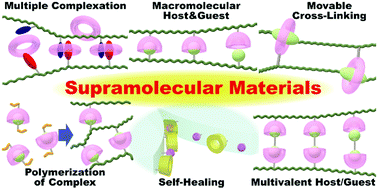Supramolecular self-healing materials from non-covalent cross-linking host–guest interactions
Abstract
The introduction of non-covalent bonds is effective for achieving self-healing properties because they can be controlled reversibly. One approach to introduce these bonds into supramolecular materials is use of host–guest interactions. This feature article summarizes the development of supramolecular materials constructed by non-covalent cross-linking through several approaches, such as host–guest interactions between host polymers and guest polymers, 1 : 2-type host–guest interactions, and host–guest interactions from the polymerization of host–guest inclusion complexes. Host–guest interactions show self-healing functions while also enabling stimuli-responsiveness (redox, pH, and temperature). The self-healing function of supramolecular materials is achieved by stress dispersion arising from host–guest interactions when stress is applied. Reversible bonds based on host–guest interactions have tremendous potential to expand the variety of functional materials.



 Please wait while we load your content...
Please wait while we load your content...